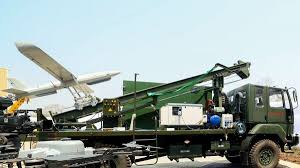
Bhargavastra: India’s Homegrown Answer to Swarm Drone Threats
Bhargavastra: India’s Homegrown Answer to Swarm Drone Threats
Modern wars are changing quickly. One of the biggest new challenges is the use of drones — especially drone swarms, where many drones fly together to attack. These can confuse or overpower traditional defense systems. To fight this, India has created and tested a new system called Bhargavastra, its first fully indigenous micro-missile solution designed to target such drone swarms.
What Is Bhargavastra and Why Was It Made?
Bhargavastra is a compact missile-based system built to destroy hostile drones, especially when they come in large groups. It was developed by Solar Defence and Aerospace Ltd (SDAL) with support from Economic Explosives Ltd (EEL) — both Indian companies.
Its main aim is to provide a low-cost, quick-reaction system that can be deployed in critical border zones or conflict areas. It has been specially designed for the Indian Army’s Air Defence units to deal with swarm attacks.
What Are Swarm Drones?
Swarm drones are groups of drones that work together like a team. These drones can fly in coordination, make decisions on their own, and continue the mission even if one or more are destroyed. This makes them harder to stop than single drones.
They are useful for:
- Surveillance (spying)
- Targeted attacks
- Covering large areas
Example: In the Russia-Ukraine war, drone swarms were used to strike military positions and gather real-time data.
Swarm drones can be controlled in different ways:
- By pre-set paths
- From a ground station
- Or using distributed intelligence, where drones talk to each other and adapt during flight.
Key Features of Bhargavastra
Detection Power
Bhargavastra can spot small drones from over 6 km away. This gives the army enough time to react and prepare a counter-strike.
Missile Strength
The system uses two types of micro-missiles:
- Unguided micro-rockets: These can hit a group of drones and have a blast radius of 20 meters.
- Precision-guided micro-missiles: These are used to target specific drones with accuracy.
It can launch up to 64 micro-missiles at once, which is very useful when facing large drone swarms.
High Mobility
Bhargavastra is mounted on a mobile platform, so it can be taken anywhere — even to high-altitude locations like the Himalayas (above 5000 meters), where Indian forces are deployed.
Layered Protection
The system can use both:
- Hard-kill methods (destroying drones using missiles), and
- Soft-kill methods (jamming or confusing the drone’s communication systems).
Its radar, sensors, and weapons can be customized depending on the battlefield need. This makes it flexible and powerful.
Advanced Control System
It has a modern Command and Control unit with C4I technology (Command, Control, Communication, Computers, and Intelligence). This helps the operator track and manage both individual drones and full swarms.
Example: If a group of 30 drones is approaching from different angles, Bhargavastra can detect, identify, and assign missiles in seconds.
Affordable Solution
Bhargavastra is much cheaper than traditional air defense systems. It lets the army save costly weapons like large anti-air missiles for bigger threats (e.g., fighter jets), while using Bhargavastra to take down smaller, cheaper drones.
Why Bhargavastra Matters for India
This system is a major milestone because:
- It’s India’s first such missile system for swarm drone defense.
- It was fully made in India, supporting the AtmaNirbhar Bharat mission.
- It shows that Indian companies can build high-tech systems that were earlier imported.
- It fills an important gap in India’s drone defense strategy.
According to developers, no other country has a homegrown system that is modular, affordable, and swarm-specific like Bhargavastra. This gives India a strong lead in this type of defense technology.
Testing and Success
In May 2025, Bhargavastra was tested at the Seaward Firing Range in Gopalpur, Odisha. It passed all tests successfully. Some of the key trial highlights:
- Two rockets fired back-to-back in just 2 seconds
- All rockets hit their targets as planned
Senior officials from the Army Air Defence unit observed the trials and were satisfied with the results.
What’s Next?
Bhargavastra is expected to be used soon by the Indian Army. There is also interest from the Indian Air Force. Future plans include:
- Mass production
- Deployment along borders
- Possible exports to friendly countries facing similar threats
Conclusion
Bhargavastra is a powerful step forward for India in modern defense technology. As drone threats become more common and dangerous, having a system like Bhargavastra will help India stay protected. It’s affordable, flexible, and fully Indian-made — showing how local innovation can solve complex global problems.
In short, Bhargavastra proves that India can not only defend itself but also lead in the future of drone warfare.